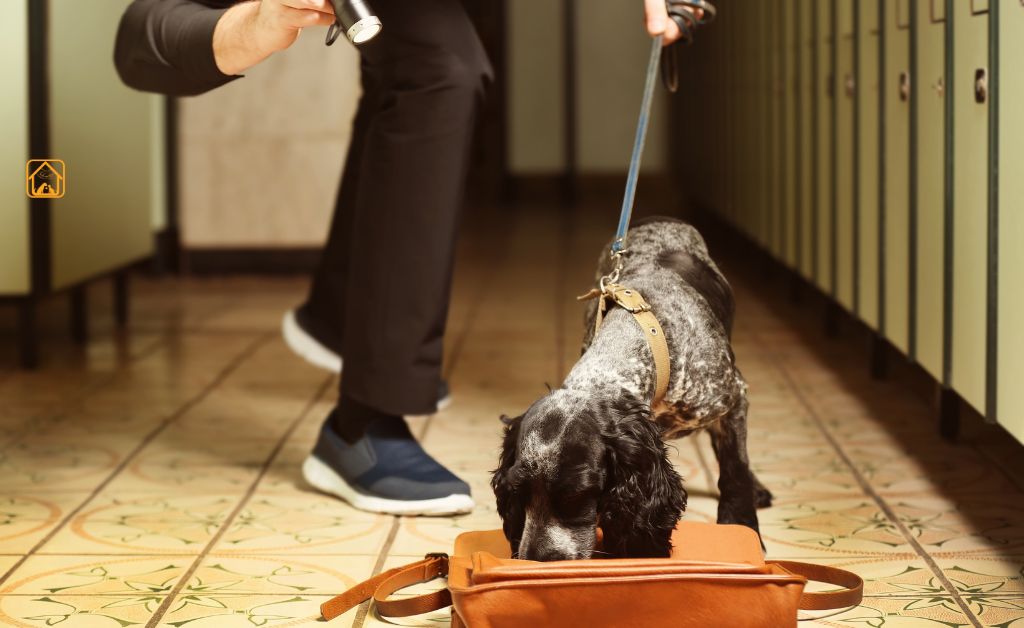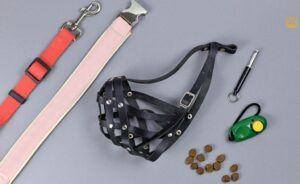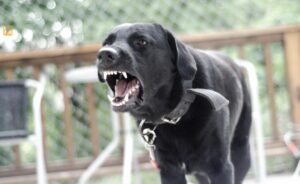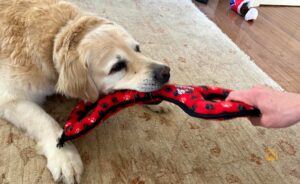What is Scent Detection Training? (Overview & Science of Dog Nosework)
Scent detection training, sometimes called dog nosework, is all about teaching your dog to find a specific smell and let you know when they’ve found it. Think of it as a treasure hunt, but instead of gold, your dog is searching for a certain scent, like birch, anise, or even bed bugs if they’re really advanced.
Dogs are born with an incredible sense of smell. While humans have around 5 million scent receptors, a dog can have up to 300 million. That’s why they can track missing people, detect medical conditions, or out-sniff the smell of a treat under the sofa.
Scent detection training builds on these natural instincts. It works by introducing a target scent, rewarding your dog for finding it, and gradually making the search harder. Over time, your dog learns to tune out distractions and focus on their job.
- Dog nosework started as a working-dog skill for police or search and rescue, but now it’s a fun sport and enrichment activity for all breeds.
- Training often uses simple scents (like birch oil on a cotton swab) and hides them in boxes, rooms, or even outdoors.
- Over time, dogs learn to indicate the found scents with a behavior like sitting, nose-touching, or pawing.
You know what’s funny? My own rescue pet Shiro, who couldn’t care less about fetch, absolutely lights up during scent games. It’s like watching a whole new side of him come alive.
Essential Scent Detection Training Equipment & Kits
Getting started with scent detection training doesn’t require a police budget. You can begin simple and build up as your dog gets the hang of it. Here’s what you’ll need for dog scent detection training at home or beyond:
- Scent Training Kit: Kits usually include target scents (like birch or anise oils), cotton swabs, and scent containers. Store them in airtight bags to keep the scent pure.
- Scent Detection Boxes: Special boxes or containers with holes let dogs sniff but not grab the target. DIY with plastic tubs, or buy purpose-made versions for competitions.
- Disposable Gloves & Tweezers: Avoid contaminating scents, handle with gloves and tweezers only.
- Rewards: Use your dog’s favorite treats or toys for big celebrations after each find.
- Clicker: Helpful for marking the exact moment your dog finds the scent.
- Leash & Harness: For keeping your dog safe and focused during searches, especially outdoors.
- Storage Bags: Keep scent aids sealed and away from your dog when not in use.
Some pros also use magnetic stash boxes, scent detection dog training aids, or advanced nosework supplies. But really, you can start with cotton swabs, essential oil, and a few cups or boxes from your kitchen.
Oh, and always supervise, one time, my friend’s Labrador tried to eat an entire scent box. Lesson learned: if it smells good, it’s fair game!
Getting Started: Step-By-Step Guide for Beginner Scent Work Dogs (At Home & with Trainers)
So you’re ready to dive into scent detection training with your dog? Whether you want to do nose work for fun or hope to join competitions someday, starting is easier than you might think. All you need is a curious dog, a few simple supplies, and a little patience. I’ll walk you through a beginner-friendly, success-building process, plus sprinkle in a few tips, I wish someone had told me when I started.
Step 1: Gather Your Essential Scent Detection Training Supplies
- Target Scent: Birch, anise, or clove oils are popular choices. For at-home practice, you can start with a drop on a cotton swab.
- Scent Containers or Boxes: Use containers with small holes (store-bought or DIY with Tupperware or muffin tins).
- Disposable Gloves and Tweezers: Prevents contaminating the scent.
- High-Value Treats or Favorite Toy: Rewards keep training positive and exciting.
- Leash and Harness: Especially useful for outdoor searches or excitable dogs.
Pro tip: Many pet parents find a beginner dog scent training kit online or at specialty pet stores.
Step 2: Build Excitement and Association with the Scent
Let your dog sniff the target scent and immediately reward them. Do this a few times, and you’ll see their interest grow. This step is about creating a positive connection, like, “Ooh, this smell means treats!”
You know what’s weird? My dog got so amped up when he saw the cotton swab, he’d start wagging before we even started the game. That’s the energy you want!
Step 3: Basic Nosework Game – The Classic “Find It”
- Hide the scented swab or container in one of several boxes or cups while your dog watches.
- Encourage your dog to sniff and let them choose. When they indicate the right box (by nosing, pawing, or sitting), mark the moment with a clicker or cheerful “Yes!” and reward them.
- Repeat, mixing up the hiding spot each time. Gradually add more boxes to make it trickier.
This is the foundation of beginner scent work dogs. Go slow. If your dog is struggling, make it easier, there’s no rush!
Step 4: Level Up – Hiding the Scent Without Your Dog Watching
Now, hide the scent while your dog is out of the room. Bring them in and use a search cue (“Find it!”). Watch for their alert: sniffing harder, tail wagging, or even freezing when they catch the scent. Always celebrate the find!
I remember the first time my dog found the scent on his own, he practically did a victory lap around the living room. That’s a confidence boost you can’t buy.
Step 5: Add Complexity – Different Rooms, Surfaces, and Distractions
- Try hiding the scent in new places: under a chair, on a shelf, or outside in the yard.
- Switch up the containers: plastic, metal, fabric pouches.
- Gradually introduce background scents (open a window, have another pet nearby) to mimic real-world challenges.
Every dog learns at their own pace. If your pup seems overwhelmed, go back a step. The goal is to keep it fun and rewarding, never frustrating.
Step 6: Working with a Professional Trainer or Scent Work Class
Ready to take things further? Many trainers offer scent detection dog training near you, ranging from group classes to private sessions. Classes provide structured learning, feedback, and a chance to meet other scent-loving pups.
Look for certified trainers who use positive reinforcement and understand the unique needs of beginner scent work dogs. You’ll pick up advanced techniques, troubleshooting tips, and maybe even get bitten by the competition bug!
Quick Reference: Beginner Scent Training At Home vs. With a Trainer
| At Home | With Trainer/Class |
| Flexible, at your pace | Expert guidance |
| Low cost, easy to start | High cost with structured skill building |
| DIY supplies | Access to pro equipment |
| Great for bonding | Socialization for dogs |
Benefits of Scent Detection Training for Dogs & Handlers
Scent detection training isn’t just about teaching cool tricks. It’s about unlocking a dog’s hidden talents and giving them a job that taps into their deepest instincts. The benefits? They’re huge, for both you and your pup.
- Mental Stimulation: Scent training for dogs is like a brain workout. Instead of mindless zoomies, your dog gets to solve puzzles and use their nose in creative ways.
- Burns Energy: Searching for scents can tire out even the most energetic dog. Ten minutes of focused nosework can rival a much longer walk.
- Boosts Confidence: Nervous or shy dogs often blossom after scent work. Every successful find builds self-assurance. I’ve seen dogs go from hesitant to headstrong just by learning to trust their own noses.
- Reduces Anxiety & Reactivity: Focusing on a scent helps anxious dogs ignore stressors around them. It’s a proven method for helping dogs with separation anxiety or noise fears.
- Strengthens Your Bond: Scent detection is a team sport. You learn to read your dog’s signals, and they learn to trust you as their guide. There’s this unspoken language that develops, and honestly, it’s magical.
- Great for All Ages: Puppies, seniors, high-drive or couch potatoes, everyone can play nosework games. It’s a gentle way to add enrichment without over-exercising.
For handlers, it’s a window into your dog’s world. You’ll see their problem-solving skills, natural talents, and even their funny quirks (like my old Bunny who’d dance a little jig every time she found her scent box!). Plus, if you love dog sports, scent detection has thriving competitions and communities to join.
Some professional benefits? Dogs trained for scent detection can help with:
- Search and rescue missions
- Medical alert (like diabetes or seizure detection)
- Finding bed bugs, narcotics, or explosives
Even if you’re just doing scent training for dogs at home, the mental and emotional rewards are real. If you ever wondered why your dog seems calmer or happier after a sniffing session, now you know, their brain is satisfied!
Best Breeds for Scent Detection: What Makes a Great Detection Dog?
If you’re picturing German Shepherds or Bloodhounds in police vests, you’re not wrong, but the truth is, most dogs can excel at scent detection training. Some breeds just have a head start, thanks to genetics.
The best scent detection dog breeds often share a few traits:
- Strong work ethic and focus
- Natural curiosity and drive to “hunt”
- Willingness to work with their handler
- High energy and stamina
| Popular Scent Detection Breeds | Why They’re Great |
| Bloodhound | Incredible scent-tracking ability, famously used in search and rescue. |
| German Shepherd | Smart, focused, and agile, stars in police and K9 work. |
| Labrador Retriever | Friendly, eager to please, and have great noses, commonly used for narcotics and explosives detection. |
| Belgian Malinois | Fast learners, high drive, and excellent scent work skills. |
| Beagle | Super scent-driven and unstoppable once on a trail, great for food or medical detection. |
| Springer Spaniel | Energetic, nose-focused, and popular in airport security jobs. |
But here’s the real secret: mixed-breed dogs, rescues, and even tiny lap dogs can succeed at nosework. I once saw a Chihuahua beat out a German Shepherd at a local nosework trial, the crowd went wild. So don’t worry if your dog isn’t a classic “detection” breed. If they love food, toys, or exploring with their nose, they can do scent work!
It’s more about attitude and motivation than pedigree. Trust me, if your dog gets excited for a game of “find the treat,” they’ve got the right stuff.
Professional Scent Training Applications: Real-World Jobs & Advanced Techniques
Scent detection training isn’t just a backyard hobby, it’s a world-class profession. Some dogs take their nosework skills to the highest level, serving in jobs that change and save lives. Ever seen a dog confidently sniffing suitcases at an airport or searching rubble after a disaster? That’s scent work in action, on the grand stage.
Where Scent Detection Dogs Work
- Search & Rescue: Locating missing people in forests, mountains, or disaster zones.
- Narcotics & Explosives Detection: Used by police, border patrol, and military teams for public safety.
- Medical Alert: Detecting changes in blood sugar, seizures, or even early signs of cancer.
- Bed Bug & Pest Detection: Specially trained dogs sniff out infestations in hotels, homes, and hospitals.
- Wildlife Conservation: Tracking endangered species, invasive plants, or illegal poaching activity.
Each job requires specialized scent detection training and often years of practice. The training is methodical, building on the same basics you can do at home.
Advanced Techniques: From Foundation to Professional
- Proofing Against Distraction: Professional dogs learn to ignore food, toys, and other animals, even in busy environments.
- Target Odor Discrimination: Training to identify a specific scent among many similar smells.
- Indication Behaviors: Dogs are taught to sit, lie down, or paw at the source without damaging it (crucial for explosives or fragile evidence).
- Systematic Search Patterns: Handlers guide dogs through grid, spiral, or area searches to ensure no spot is missed.
- Multiple Odor Detection: Some dogs can identify several scents, like a narcotics dog trained for cocaine, heroin, and methamphetamines.
Here’s the part that always stuns people: most detection pros use play as the main reward. For many dogs, finding the scent means they get to chase their favorite ball or tug toy. It’s all about motivation and making the “job” feel like the world’s best game.
Want to learn more? This scientific review covers how detection dogs are trained and the science behind their performance.
How Do Handlers and Dogs Work Together?
Handler beliefs and teamwork truly matter. Studies show that when a handler trusts their dog, outcomes improve. Good handlers learn to read subtle signals, like a pause, a head tilt, or a change in breathing, and respond without accidentally cueing the dog. It’s a partnership built on communication and respect.
Honestly, I’ve seen handlers beam with pride when their dog finds something no human could. It’s a bond you don’t forget.
Quick Comparison: Hobby vs. Professional Scent Detection
| Hobby/At-Home | Professional |
| Emphasis on fun, enrichment | Job-specific, real-world stakes |
| Simple scents or treats | Target scents (narcotics, explosives, medical) |
| Flexible structure | Strict protocols, detailed record-keeping |
| Any breed or age | Often specific breeds, selected for traits |
If you’re inspired, many organizations welcome volunteers to train for search and rescue or therapy scent work. It’s a way to make an incredible impact with your dog’s nose.
Common Challenges, Handler Beliefs, and How to Avoid Training Mistakes
Let’s be honest, scent detection training isn’t always smooth sailing. Every handler, from newbie to pro, hits a few bumps along the way. The good news? Most problems have simple fixes. And sometimes the hardest part is not your dog, but your own expectations.
Top Scent Detection Training Challenges
- Overcomplicating Early Training: If you make it too tough too soon, your dog can get frustrated and lose interest. Start simple, build confidence, and only add difficulty once your pup is reliably finding the scent.
- Scent Contamination: Accidentally touching the target scent with your bare hands can confuse your dog. Always use gloves and tweezers to keep scent aids pure.
- Handler Cues or “Body Language Hints”: Dogs are experts at reading us. Sometimes, we give away the answer by staring at the hiding spot or unconsciously signaling with our body. Try to stay neutral and let your dog lead.
- Distraction Overload: Training in noisy, busy places too early can overwhelm your dog. Gradually work up to more challenging settings.
- Inconsistent Rewards: If you’re inconsistent with praise or treats, your dog may get confused about what earns a reward. Mark the right moment every single time.
How Handler Beliefs Affect Scent Detection Dog Outcomes
It might sound odd, but what you believe about your dog’s ability can shape their success. Research shows that when handlers expect their dogs to perform well, they tend to be more encouraging and patient, and dogs pick up on that. On the flip side, if you’re skeptical or anxious, your dog may hesitate too.
You know what’s funny? I used to doubt my Shiro would ever get the hang of nosework. Turns out, she just needed me to trust her, now she’s the star of every class!
How to Avoid the Most Common Training Mistakes
- Keep sessions short and fun, end on a success, even if it’s a tiny win.
- Watch your own signals. Practice “poker face” handling so your dog isn’t just reading you.
- Handle scent aids carefully to prevent mixing smells.
- Be patient. Progress isn’t always linear, some days will be better than others.
- Ask for help! If you hit a wall, reach out to a scent detection dog trainer or join a local class for feedback.
The most important thing? Allow yourself and your dog to make mistakes. Every “oops” is a learning opportunity, not a failure.
FAQs about Scent Detection Training
What is the difference between nosework and scent detection dog training?
Nosework is often used for fun or sport, teaching dogs to find specific scents in a recreational setting. Scent detection dog training can include professional applications (like detecting drugs, missing persons, or bed bugs) and may involve more advanced skills and rigorous standards. Both use similar training methods, and both are great for dogs!
Which dog breed is known for its ability to be a scent detection dog?
Bloodhounds are legendary for their scenting skills, but German Shepherds, Labradors, Belgian Malinois, and Springer Spaniels are also commonly used. However, most dogs, regardless of breed, can enjoy and excel at scent training for dogs at home.
What scent to use for scent training?
Common scents for beginner nosework include birch, anise, and clove oils (used in nosework competitions). For specialized work, scents might include bed bug odor, narcotics, or medical samples. Always use safe, dog-friendly scents and follow guidelines for your chosen activity.
Can I do scent detection training for dogs at home?
Absolutely! Scent training for dogs at home is simple with a dog scent training kit, some treats, and a little creativity. Start with easy scent games, then gradually make searches more challenging. Classes and online tutorials can also help if you want more structure.
How long does it take to train a scent detection dog?
It depends on your dog’s age, motivation, and your consistency. Some dogs pick up basic nose work games for dogs in a few sessions. Professional scent detection dog training for specialized tasks (like bed bug scent detection training) can take months or even years of practice and proofing.
What are common mistakes to avoid in scent detection training?
Common mistakes include skipping steps, contaminating scent detection training aids, not using high-value rewards, or accidentally cueing your dog. Take it slow, keep sessions fun, and always observe your dog’s body language.
Do I need special equipment for dog scent detection training?
While professional training uses specific scent detection dog training equipment, you can start with household items like boxes and cotton swabs. As you progress, consider investing in a scent detection training kit for more advanced work.
Conclusion
Scent detection training turns your dog’s nose into their superpower. It’s not just fun, it’s fulfilling. Whether you’re bonding at home or dreaming of future competitions, nosework unlocks joy, focus, and purpose. So grab a scent, follow the sniff, and let your dog’s hidden talent lead the way!



